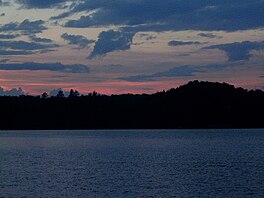| This article needs additional citations for verification. Please help improve this article by adding citations to reliable sources. Unsourced material may be challenged and removed. Find sources: "Skeleton Lake" Ontario – news · newspapers · books · scholar · JSTOR (August 2010) (Learn how and when to remove this message) |
| Skeleton Lake | |
|---|---|
 | |
 | |
| Location | Huntsville & Muskoka Lakes, Ontario, Canada |
| Coordinates | 45°15′02″N 79°27′01″W / 45.25056°N 79.45028°W / 45.25056; -79.45028 |
| Type | Lake |
| Max. length | 8.3 km (5.2 mi) |
| Max. width | 4.8 km (3.0 mi) |
| Surface elevation | 280 m (920 ft) |
Skeleton Lake is a lake in the municipalities of Huntsville and Muskoka Lakes in the District Municipality of Muskoka, Ontario, Canada, about 17 kilometres (11 mi) west of the town centre of Huntsville. Up until 1991, the Ministry of Natural Resources operated a fish hatchery on the lake.
Geography
The lake is about 8.3 kilometres (5.2 mi) long and 4.8 kilometres (3.0 mi) wide, lies at an elevation of 280 metres (919 ft) and is in the Lake Huron drainage basin. The sole outflow is the Skeleton River at the west of the lake. It is controlled by the Skeleton Lake Dam and flows through the community of Bent River to Skeleton Bay on Lake Rosseau.
There are two public use islands in the area. The Hog's Back is a small rock island which used to exhibit much religious graffiti, but has since been eco-scrubbed and now is a bare rock with a fire pit, near Greer Bay. Anderson's island has a population of silver birches, along with a cliff-jumping area on the south-east side of the island, and also has religious oriented graffiti carved into the trees and painted onto rocks. Other public access areas exist including a government dock in Wilson's Bay.
Geology
The lake is thought to have been formed as a result of a meteorite impact. About 800 million years ago, an asteroid impact is suspected to have created a crater much larger than the remnant lake. Periods of glaciation since then have removed the original crater, leaving a lake approximately 2.2 miles across and 100 meters deep at its center. Skeleton Lake is recognized as a suspected impact crater. Ironclad evidence of the impact hypothesis would have been removed during the ice ages, and unless more shock geomorphology is found the crater's origin cannot be certified beyond a reasonable doubt. Due to the spring fed nature of the lake, the water is exceptionally clear. According to residents of the lake, on calm days it is possible to see up to 30 metres (98 ft) underwater with the naked eye.
Folklore
Skeleton Lake, or the pool of bones, is so named because when surveyors were working on the north shore, they came upon two skeletons resting on the rocks. When they asked a local Indian chief where the skeletons came from, they were told that he and his people had camped one winter on Skeleton Lake. When food became scarce the tribe decided to move elsewhere. One mother, with a fourteen-year-old son too weak to move, refused to accompany them. They died together of starvation, and the lake was named in memory of this mother and her son. It is said there is an underground current that leads south but no attempts have been made to find where it leads.
Recreation
The open body of water in Skeleton Lake is about the largest open body of water in all the Muskoka Lakes. This makes it an excellent lake for such sports as sailing and windsurfing, though there can be rough water.
Fishing is very difficult in the lake. Bass and trout can be caught. In the spring, lake trout will strike at minnows in cold shallow water. Later in the summer, trout like to stay in cold water below the second thermocline, which is typically 50–70 feet. This requires down-riggers to get the bait to the right depth. Bass can be caught in shallower depths.
There is a cottagers' association for the many cottagers who spend their time at Skeleton Lake.
Summer Camps
Skeleton Lake is home to several religion-based camps including Camp Ramah in Canada, a Jewish summer camp; Camp Kwasind, a Baptist camp; and Camp Newport, operated by The Salvation Army.
See also
References
- O'Dale, Charles (20 June 2010). "Odale-Articles-Skeleton". Ottawa Centre of the Royal Astronomical Society of Canada. Archived from the original on 20 July 2011. Retrieved 9 August 2010.
- "Skeleton Lake Cottagers Organization". Archived from the original on 6 July 2011. Retrieved 9 August 2010.
External links
- Aerial documentation of the Skeleton Lake structure – RASC
- "Skeleton Lake". Geographical Names Data Base. Natural Resources Canada. Retrieved 9 August 2010.
- "Topographic Map sheets 31E3, 31E4, 31E6". Atlas of Canada. Natural Resources Canada. 4 February 2010. Retrieved 9 August 2010.